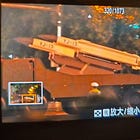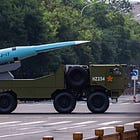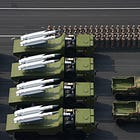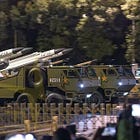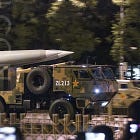Unveiling Of Six New Chinese Anti-Ship Munitions Highlights A Transformed Regional Naval Balance
🇨🇳 Analysis
The major military parade held in Beijing on 3 September 2025 served as an opportunity for China to unveil no fewer than six qualitatively distinct anti-ship munitions. While a significant development in and of itself and a significant development for the all-important China-United States military balance, the unveiling and presumed operational status of such a diverse array of anti-ship munitions highlights a transformed regional naval balance in the South China Sea that leaves most Southeast Asian countries unable to keep up and deploy credible naval forces for the foreseeable future. Given this, observers should recognize that the widespread fixation on whether China has matched or surpassed American military power misses a crucially important point: the military capabilities of most other countries in the Western Pacific are increasingly irrelevant in the head-to-head clash between the two leading military powers.
The recent military parade in Beijing was used to formally unveil the following anti-ship munitions:
YJ-15: an air-launched ramjet-powered supersonic anti-ship cruise missile
YJ-17: a ship- and possibly submarine-launched anti-ship boost-glide vehicle, which is to say an offshoot of ballistic missile technology
YJ-18C: a seemingly subsonic ship/submarine-launched anti-ship cruise missile
YJ-19: a seemingly submarine-launched scramjet-powered boosted high-altitude cruise missile
YJ-20: a ship- and possibly submarine-launched anti-ship ballistic missile
YJ-21: an air-launched anti-ship ballistic missile
Of these, only the existence of the YJ-20 and YJ-21—sans designations—was public knowledge prior to the rehearsals for the 3 September parade. No other country is known to have developed, let alone (seemingly) deployed, such a diverse array of qualitatively distinct anti-ship munitions that, in effect, occupy essentially every imaginable niche when it comes to long-range maritime strike capabilities. I covered most of the aforementioned Chinese anti-ship munitions in several recent posts.
Prior to the recent unveiling of the aforementioned anti-ship munitions, China’s maritime strike capabilities were much-hyped but, if one went by publicly available information, often overstated. Yes, the People’s Liberation Army Rocket Force (PLARF) operated the DF-21D, DF-26, and DF-17—so-called “carrier killers,” the PLA Navy (PLAN) deployed the YJ-12—primarily on land, the PLAN operated the YJ-18—at sea, and the PLA Air Force (PLAAF) the YJ-12 on its bomber aircraft, but the most widely deployed Chinese anti-ship munition was—and seemingly remains—the exceedingly modest subsonic and comparatively very short range YJ-83. The YJ-83 anti-ship cruise missile was and is not a particularly difficult aerial target when it comes to detection and interception.
Given the PLA’s maritime strike capabilities, Southeast Asian navies could make a persuasive enough case to their governments as to why the procurement of new warships—corvettes or frigates—was justified. With the introduction of the new crop of Chinese anti-ship munitions, however, Southeast Asian countries, among others, need to reassess their fleet planning and their assumptions about the future threat environment. The frigates and corvettes, among other naval vessels, that Southeast Asian countries are pursuing are simply not viable against such formidable threats. To be clear, I do not contend that the YJ-15, YJ-17, YJ-18C, YJ-19, YJ-20, and YJ-21 are, as individual munitions or a collective, uncounterable; I only contend that Southeast Asian navies are, unlike the navies of countries like the United States and Japan and the sole exception of Singapore, very poorly positioned to deploy meaningful countermeasures to such threats. None of the Southeast Asian navies has any naval ballistic missile defence capability, and only Singapore is in any position to develop such an expensive capability. Leaving aside well-resourced Singapore, none of the Southeast Asian countries is procuring or is in a position to procure larger, better-equipped, and far more expensive warships that can carry the sensors, air defence munitions—large numbers of expensive air defence munitions at that—required to remain credible at sea in the face of China’s formidable maritime strike capabilities.
As things stand, Southeast Asian countries other than Singapore regularly cut corners in naval procurement in order to develop fleets that are more impressive on paper than in practice—and larger than fleets would otherwise exist if these countries procured more capable and more expensive warships with the same very limited budget. While Southeast Asian fleets were, of course, increasingly overshadowed by the PLAN over the course of the 2010s, their relative standing vis-a-vis China in 2025 and going forward is worse than it has ever been. Given the current and emerging threat environment, Southeast Asian countries are likely to be better off investing their limited resources in submarines, land-based anti-ship munitions, and maritime intelligence, surveillance, and reconnaissance (ISR) capabilities more generally, as well as terrestrial air defences. Contestations in the disputed waters of the South China Sea may require fairly large vessels, but do not require expensive vessels equipped with medium-end sensors and armament, not least when going head-to-head with the Chinese Coast Guard and Chinese maritime militia, which are backstopped by the PLAN and the rest of the PLA more generally.
It bears emphasis that the six recently unveiled Chinese anti-ship munitions are likely to be just the tip of the iceberg as to what is to come over the coming decade or so. Supposing that the YJ-15, YJ-17, YJ-18C, YJ-19, YJ-20, and YJ-21 are all currently operational, many of the designers involved in the development of this extremely diverse array of anti-ship munitions are likely engaged in research and development activity that will lead to the next generation of PLA anti-ship munitions or at least upgraded versions of the aforementioned designs. More generally, developments in other areas of PLA capabilities, such as the ongoing rapid evolution of the PLAN’s aircraft carrier force and the development and deployment of a new generation of combat aircraft for the PLAAF, are profoundly reshaping the ex-United States regional military balance. While it is not game over for Southeast Asian countries, many of which have fast-growing economies (that are, for the most part, reflective of base effects), resources are always finite and must be prudently allocated. As things stand, the transformed regional naval balance leaves little incentive for Southeast Asian navies to put out to sea.



